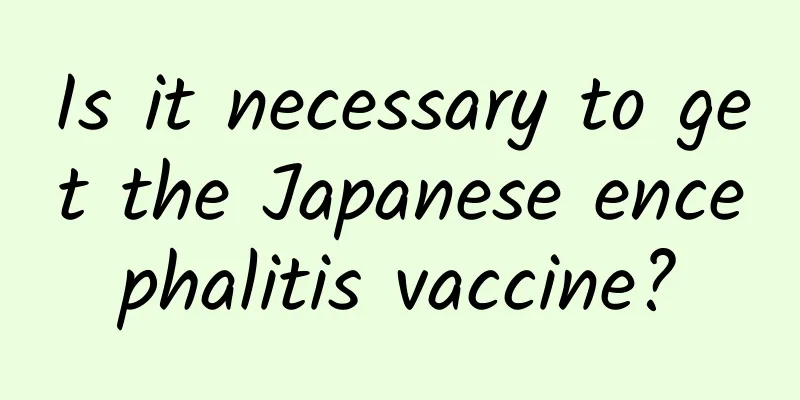Is it necessary to get the Japanese encephalitis vaccine?

|
Many parents have heard of the term "Japanese encephalitis vaccine", but we still do not have an in-depth understanding of it, so we often ask the question: Is it necessary to get the Japanese encephalitis vaccine? In fact, as long as we know what the Japanese encephalitis vaccine is, its role and efficacy, and what benefits it brings to our body, we will know whether we should get the Japanese encephalitis vaccine. Modern medical advances have brought about great changes in the way we deal with diseases. In the past, we would treat diseases only after they occurred, but now we prevent diseases because prevention is much easier than treatment. Japanese encephalitis vaccine is an effective measure to prevent Japanese encephalitis. Epidemic Japanese encephalitis, abbreviated as JE, is an acute infectious disease that attacks the central nervous system and is caused by the Japanese encephalitis virus, an insect-borne virus of the Flaviviridae family. It often causes death or leaves neurological sequelae in patients. Japanese encephalitis is a zoonotic disease transmitted by mosquitoes. Humans and many animals (livestock, poultry and birds) infected with the Japanese encephalitis virus can become sources of infection. Japanese encephalitis is mainly transmitted through mosquito bites. Epidemic encephalitis B (also known as Japanese encephalitis B, abbreviated as JE) is a natural epidemic disease caused by a neurotropic virus. It is caused by the bite of a mosquito carrying the JE virus. The incubation period of Japanese encephalitis virus in the human body is 6 to 16 days. Most people who are bitten do not develop the disease and the infection is latent. Only a very small number of people will develop the disease. The incidence rate is generally between 2 and 10/100,000, and the mortality rate is relatively high (5% to 50%). About 1/3 of the survivors will suffer from lifelong neuropsychiatric disorders after recovery. Due to the large-scale vaccination and latent infection in the population, children have become the main victims of the disease. China has the largest number of Japanese encephalitis cases in the world. To date, the number of Japanese encephalitis cases in the country each year accounts for more than % of the total number of cases in the world that year. Since 1950, there have been three major outbreaks of Japanese encephalitis (1957, 1966 and 1971), each lasting three to four years. Since 1971, except for outbreaks in some areas across the country, the incidence of Japanese encephalitis has remained at a low level (<5/100,000) in most provinces and regions. The prevalence of Japanese encephalitis in China has three notable characteristics: 1. Strict seasonality, mainly limited to summer and autumn (June to October), with the peak of the epidemic in August to September, and the difference between the southern and northern regions can be about 10 days. ②The cases are highly sporadic. ③The distribution range is wide. Except for Tibet, Qinghai and Xinjiang, which are non-epidemic areas, the disease is prevalent to varying degrees in other regions. In the past decade or so, due to the influence of many factors such as temperature, rainfall and the prevalence of dengue fever in the southern coastal areas, the Japanese encephalitis epidemic area has shown a clear trend of moving northward. Years of research have confirmed that Culex tritaeniorhynchus is the main vector of Japanese encephalitis; pigs are the main spread host, and humans, horses and other mammals and birds can also serve as hosts. Japanese encephalitis virus can cause equine encephalitis and pig abortion after infecting horses and pigs. As a natural epidemic disease, the epidemic intensity of Japanese encephalitis depends on the density of the main transmission vectors, the number of main spread hosts and the susceptibility of the population. These factors change due to changes in many natural environmental factors. Therefore, changes in natural environmental factors during the epidemic period of Japanese encephalitis and in the month before the epidemic period, especially the occurrence of natural disasters (drought, floods, earthquakes, etc.), will have a great impact on the prevalence of Japanese encephalitis. Above we introduced the importance of disease prevention. If the disease can be suppressed before it occurs, it will definitely not cause harm to the body. The Japanese encephalitis vaccine mentioned above is of great significance, so we recommend that it is necessary to get the Japanese encephalitis vaccine. I hope the above article can help everyone.
|
>>: Why do I keep coughing at night?
Recommend
How long can a person with hyperthyroidism live?
How long can a person with hyperthyroidism live? ...
Neurasthenia
Of course, everyone hopes to have a healthy body,...
Children's ears and eyes
Careful parents will observe that their baby has ...
What is herpetic gingivostomatitis
We should all be familiar with herpetic gingivost...
Treatment of athlete's foot
Athlete's foot is a very common and extremely...
Wonderful prescriptions for treating constipation from ancient times to the present
With the development of today's society, the ...
What is the Chinese medicine for dispelling cold and dampness?
There are many kinds of traditional Chinese medic...
Symptoms of otitis externa
Our ears are very sensitive organs. Many friends ...
What should women eat to nourish yin and nest? Don't miss these foods
Nourishing the yin and nourishing the nest is som...
Traditional Chinese Medicine Treatment of Pericardial Effusion
Pericardial effusion has a great impact on the pa...
What is the white stuff on the cervix?
Cervical disease is the most common disease among...
The harm of anesthesia to the body
Painless abortion surgery is very common nowadays...
What medicine should I take for stomach acid bad breath?
Gastric acid plays a very special role in human d...
What to do if the tooth root is rotten
Tooth decay is quite common in our daily life, an...
Who can't eat Houttuynia cordata?
Houttuynia cordata has the effects of enhancing h...









